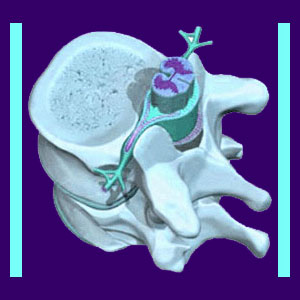
Lateral recess stenosis, also called subarticular stenosis, is a common condition that can compress a single nerve root usually in the neck or lower back. While very similar to foraminal stenosis, lateral stenosis is a slightly different diagnosis, although it can create identical symptoms to neuroforaminal opening reduction.
What are the causes of lateral spinal stenosis? How can the condition be treated for the best chance of providing a cure? What are the common misconceptions of lateral stenosis? These are all important questions that will be answered during the course of this focused dialog.
This article provides a simple explanation of lateral recess stenosis, as well as helping diagnosed patients to make better informed healthcare decisions by debunking common myths about subarticular stenosis.
What is Lateral Recess Stenosis?
The lateral recesses exist between the central spinal canal and the foraminal openings. When nerve roots separate off the spinal cord or cauda equina, they travel a short distance through the central spinal canal to exit the spine through the foraminal openings which exist between vertebral bones. At the point where the central canal narrows into the foraminal canal prior to the foraminal opening, this location is called the lateral recess. It is the beginning of a short passage traversed by the exiting nerve root, while the foraminal opening is the end…
It is common for the lateral recess to suffer impingement by various types of spinal structural changes. Some of the most common causes of lateral recess stenosis include:
Degenerated discs decrease the space between vertebral bones and create both foraminal and lateral recess stenosis as a direct result of intervertebral desiccation.
Herniated discs often bulge into the lateral recess, particularly those of the posterolateral variety, which happen to be the most common of all herniated discs.
Arthritic spinal stenosis can affect the lateral recesses, as well as the foraminal openings and the central spinal canal. In fact, it is normal and basically universal to observe stenosis in the lateral recesses of adults in the mid to lower cervical and lower lumbar regions of the vertebral column.
Ligamentous issues can sometimes contribute to lateral recess stenosis.
Misalignments of the spinal canal will often result in significant lateral recess stenosis. The typical causes of these misalignments include spondylolisthesis, scoliosis, and various types of kyphosis and lordosis.
Stenosis of the Lateral Recess
Symptomatic subarticular stenosis will occur when the lateral recess becomes so small that the exiting nerve root will suffer structural compression. In order for this to occur, nearly the entire lateral recess must be closed off, since the nerve is very small and tends to function just fine despite mild to moderate degrees of stenosis. When a pinched nerve does occur, symptoms can be wide ranging in location, expression, duration and severity, depending on many factors and might include:
Tingling, numbness and weakness are commonly observed in the area of the body served by the affected nerve. If the nerve exists in the neck, symptoms will appear in the shoulders, arms or hands. If the nerve exists in the lower back, symptoms will appear in the legs and/or feet. These lower body symptoms are called sciatica.
Pain might exist locally in the spine or may not. Chronic pain is not an indication of a pinched nerve, since most conditions will progress to numbness and eventual weakness instead.
Functional deficits in the innervated bodily locations might exist, including such expressions as foot drop.
Symptoms should follow strictly defined patterns as far as locations affected, since they can be traced to a specific nerve root. Widespread or variable location symptomology is virtually always a sure sign of misdiagnosis when it comes to pinched nerves.
Lateral Recess Stenosis Treatment
Lateral recess stenosis can be treated conservatively to provide symptomatic relief for some patients. Minor cases are easily managed using noninvasive care to minimize discomfort and maximize physical functionality.
Spinal decompression treatment can provide a true cure for some types of lateral recess stenosis, especially those caused by degenerated and herniated discs. This is why modern nonsurgical decompression continues to be a wise choice for patients who want to avoid surgery on the spine.
Back surgery can resolve focal areas of symptomatic stenosis and typically address several problematic locations at once, including the lateral recesses, central spinal canal and neuroforaminal openings.
It must be noted that the vast majority of lateral spinal stenosis is not symptomatic, nor will it become so. Therefore, treatment is only needed in cases that are verified as causing compression of nerve tissues, which account for a small percentage of all people who demonstrate mild to moderate lateral recess stenosis.





